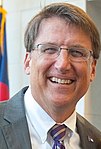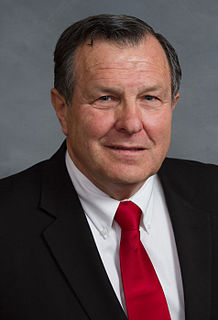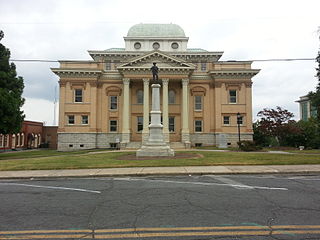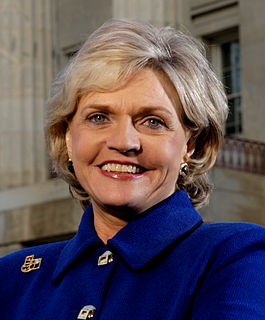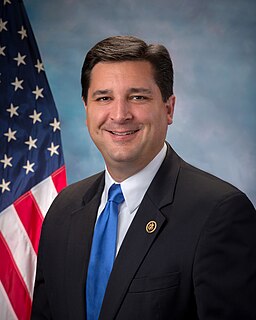Preliminary results and legal battle
North Carolina's gubernatorial election, 2016 [37] | Party | Candidate | Votes | % | ± |
|---|
| Democratic | Roy Cooper | 2,309,162 | 49.02% | +5.79% |
| Republican | Pat McCrory (Incumbent) | 2,298,881 | 48.80% | -5.82% |
| Libertarian | Lon Cecil | 102,978 | 2.19% | +0.06% |
| Margin of victory | 10,281 | 0.22% | -7.92% |
|---|
| Turnout | 4,711,021 | 68.98% | +1.68% |
|---|
| Democratic gain from Republican |
|
Polls closed at 7:30 pm on election day. On election night, as votes were tallied, Cooper held an early lead, but was overtaken by McCrory around 9:30 pm, and McCrory held the lead for most of the evening. Shortly before midnight, McCrory held a 60,000 vote lead until a block of 90,000 votes from Durham County was added to the total, putting Cooper back in the lead by fewer than 5,000 votes out of 4,500,000 cast. [5] Both candidates addressed supporters around 12:30 am; Cooper declared victory, while McCrory vowed the race was not over and that every vote needed to be counted. [5]
Under North Carolina state law, absentee ballots postmarked on or before election day must be counted, and military and overseas ballots accepted through November 17 must also be counted. [38] Additionally, election administrators "must decide the eligibility of more than 60,000 provisional ballots and the validity of thousands of challenged votes." [38] This process, plus a protracted legal challenge from the McCrory campaign, was likely to leave the election result not formally decided for some time after election day. [38]
McCrory's campaign said that it had "grave concerns over potential irregularities in Durham County." [5] Republican Party of North Carolina Chairman Robin Hayes called Cooper's declaration of victory "rude and grossly premature." [7] On November 10, 2016, both campaigns announced they had retained attorneys in anticipation of a protracted legal battle: Cooper hired lawyers from Washington-based firm Perkins Coie (including Marc Elias [39] ), while McCrory hired lawyers from Virginia-based firm Holtzman Vogel Josefiak. [7]
Once all ballots are counted, North Carolina election law allows either candidate to request a recount if the margin is fewer than 10,000 votes. [7]
On November 12, the general counsel of the Durham County Republican Party filed a formal protest with the Durham County Board of Elections alleging "malfeasance" in the tallying of votes in Durham County and calling for a recount. [40] McCrory's campaign said that the 90,000 votes added to the total late on election night appeared to have come from corrupted memory cards. A campaign spokesman said, "What transpired in Durham County is extremely troubling and no citizen can have confidence in the results at this point in time." [40]
On November 14, WRAL reported that there was speculation among political operatives about whether the race could possibly be contested and handed to the North Carolina General Assembly to determine the winner, as was done in 2005, when the General Assembly made June Atkinson the winner of a disputed election for the office of North Carolina Superintendent of Public Instruction. [41] North Carolina House Speaker Tim Moore said getting the General Assembly involved would be "an absolute last resort". [42]
Also on November 14, WRAL reported that the State Bureau of Investigation was investigating whether crimes were committed in the mishandling of 1,000 ballots in the March 2016 primaries in Durham County, the likely epicenter of the battle over the gubernatorial race. [43] The Durham County electoral board chairman said there was no connection between the investigation and the gubernatorial race. [43]
On November 15 Bladen County Soil and Water Conservation District Supervisor McCrae Dowless, a Republican and the incumbent for reelection, filed a protest with that county's board of elections over several hundred absentee ballots cast for Cooper and other Democrats, claiming that they were fraudulent; on the basis of similarity of the handwriting with which they were filled out. In his initial filing, Dowless claimed corroboration by a handwriting expert. The complainant had initially expressed concerns about voter fraud related to his own reelection campaign, and before election day. [44] [45] [46] The McCrory campaign alleged that the ballots were filled out by paid employees of the Bladen County Improvement Association PAC, a political action committee that received funding from the North Carolina Democratic Party. [44] The complaint alleged that one person served as a witness for at least 67 mail-in absentee ballots, and the same person appeared to have filled out the selections on 71 ballots. [47] It said there were at least 250 questionable ballots connected to five people paid by the Bladen County Improvement Association PAC. That organization has responded that the people involved were volunteers with their get-out-the-vote effort, and that the only payments made to them were small stipends for expenses incurred as part of that activity; such as food and gas costs. [48] The McCrory campaign stated, "A massive voting fraud scheme has been uncovered in Bladen County." [48] In response, the Cooper campaign stated: "Governor McCrory has set a new standard for desperation in his attempts to undermine the results of an election he lost." [49]
On November 16, the McCrory campaign announced it had filed election protests alleging fraud in 11 more counties. [6] [50] On November 17, the McCrory campaign announced the number of counties in which it had filed protests alleging voter fraud had grown to 50 counties, [49] [51] which the Associated Press reported were "without offering detailed proof." [52]
Every county election board in the state has three members: two Republican appointees and one Democrat. [39] [53]
Durham County has been seen as the most pivotal county, as it has the most votes at stake. [39] On November 16, the Durham County Board of Elections voted 2-1 to hold an evidentiary hearing on election protest about the ballots in Durham County. [54] At the hearing on November 18, the board unanimously dismissed the protest, with the board's Republican chairman, William Brian Jr., saying that all the evidence shows that the count is correct. [52]
By November 18, Cooper's unofficial advantage over McCrory had grown to about 6,600 votes, out of almost 4.7 million cast. [52] [53]
On November 20, the state Board of Elections held an emergency meeting. They declined a McCrory campaign petition for the state board to take jurisdiction over all 50 county election protests, except for the one in Bladen County, which they took over. [55] They decided to convene another meeting on November 22 to issue guidance to county boards on how to handle the protests. [56]
On November 22, the McCrory campaign formally requested a statewide recount. [8]
Also on November 22, the Civitas Institute filed a federal lawsuit seeking an injunction to delay the State Board of Elections' count of ballots of unverified same-day registrants, alleging that there is not enough time to verify the eligibility of voters who registered to vote on election day. [57] Civitas said that neither the McCrory campaign nor the state Republican Party were involved in the lawsuit. [58] Civitas cited a 2012 review conducted by the state Board of Elections that found 2.44% of voters who used same-day registration in 2012 failed the verification process, but the process was not completely finished when the ballots were counted. [58] A court hearing is scheduled for December 8. [59]
On November 26, the Durham County Republican Party's general counsel asked the state Board of Elections to hold an expedited hearing on his appeal of the Durham County Board of Elections' refusal to conduct a recount of that county's votes. [60] The campaign stated they would withdraw their request for a statewide recount if a manual recount of Durham County votes produced the same results as were reported on election day. [61]
On November 30, the State Board of Elections ordered a recount of the Durham County votes. [9] The recount was to be completed by 7 p.m. on December 5. However, by that morning, early results showed no change in the tally. McCrory announced on his campaign's YouTube channel that he was conceding the race to Cooper, saying that it was now clear that "the majority of our citizens had spoken." [10]






